|
|
|
|
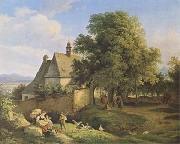 |
Adrian Ludwig Richter
|
|
German, 1803-1884
German painter, printmaker and illustrator. He ranks with Moritz von Schwind as the most important representative of late Romantic painting and printmaking in Germany. In contrast to the work of such leading masters of early Romanticism as Philipp Otto Runge and Caspar David Friedrich, which was ambitious in content and innovative in form, Richter's art was more modest in its aims, in line with the restrained intellectual climate of the Biedermeier period. |
|
|
|
|
|
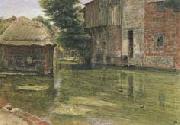 |
Albert Goodwin,RWS
|
|
1845-1932
English painter. During the early 1860s Goodwin studied with Arthur Hughes and Ford Madox Brown, who predicted that his pupil would become 'one of the greatest landscape painters of the age'. Hughes and Brown impressed on Goodwin the Pre-Raphaelite principles of high finish, vivid colour and working directly from nature that inform his early landscape style |
|
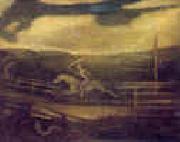 |
Albert Pinkham Ryder
|
|
1847-1917
Albert Pinkham Ryder Gallery
Albert Pinkham Ryder (March 19, 1847 ?C March 28, 1917) was an American painter best known for his poetic and moody allegorical works and seascapes, as well as his eccentric personality. While his art shared an emphasis on subtle variations of color with tonalist works of the time, it was unique for accentuating form in a way that some art historians regard as modernist.
After 1900, around the time of his father's death, Ryder's creativity fell dramatically. For the rest of his life he spent his artistic energy on occasionally re-working existing paintings, some of which lay scattered about his New York apartment. Visitors to Ryder's home were struck by his slovenly habits -- he never cleaned, and his floor was covered with trash, plates with old food, and a thick layer of dust, and he would have to clear space for visitors to stand or sit. He was shy and did not seek the company of others, but received company courteously and enjoyed telling stories or talking about his art. He gained a reputation as a loner, but he maintained social contacts, enjoyed writing letters, and continued to travel on occasion to visit friends.
While Ryder's creativity fell after the turn of the century, his fame grew. Important collectors of American art sought Ryder paintings for their holdings and often lent choice examples for national art exhibitions, as Ryder himself had lost interest in actively exhibiting his work. In 1913, ten of his paintings were shown together in the historic Armory Show, an honor reflecting the admiration felt towards Ryder by modernist artists of the time.
By 1915 Ryder's health deteriorated, and he died at the home of a friend who was caring for him. A memorial exhibition of his work was held in the Metropolitan Museum of Art in New York in 1918. While the works of many of Ryder's contemporaries were partly or mostly forgotten through much of the 20th century, Ryder's artistic reputation has remained largely intact owing to his unique and forward-looking style. Ryder was along with Thomas Hart Benton, David Siqueiros and Pablo Picasso an important influence on Jackson Pollock's paintings. |
|
|
|
|
|
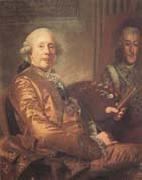 |
Alexander Roslin
|
|
1718--93
Swedish painter and pastellist, active in Germany and France. He trained with Lars Ehrenbill (1697-1747), a draughtsman employed by the Admiralty in Malmö, and in Stockholm under Georg Engelhardt Schräder (1684-1750), a portrait painter working in the tradition of Hyacinthe Rigaud and Nicolas de Largillierre. In 1741 Roslin moved to Göteborg, but the following year he returned to Malmö, where he executed devotional works for the parish church of Hasslöv, Halland, and began establishing himself as a portrait painter. |
|
|
|
|
|
|
|
|
|
 |
Alfred R. Waud
|
|
American, 1828-1891,was an American artist and illustrator, born in London, England. He is most notable for the sketches he made as an artist correspondent during the American Civil War. Before emigration, Alfred Waud had entered the Government School of Design at Somerset House, London, with the intention of becoming a marine painter. This did not come to fruition, but as a student, he also worked as a painter of theatrical scenery. He intended to pursue that work in the United States, when he immigrated in 1850, seeking employment with actor and playwright John Brougham. In the 1850s, he worked variously as an illustrator for a Boston periodical, the Carpet-Bag, and provided illustrations for books such as Hunter's Panoramic Guide from Niagara to Quebec (1857). The period during the American Civil War was time when all images in a publication had to be hand drawn and engraved by skilled artist. Photography existed but there was no way to transfer a photograph to a printing plate since this was well before the advent of the halftone process for printing photographs. Photographic equipment was too cumbersome and exposure times were to slow to be used on the battlefield. An artist such as Waud would do detailed sketches in the field, which were then rushed by courier back to the main office of the newspaper they were working for. There a staff of engravers would use the to sketches create finished engravings for publication. In 1860 Alfred Waud became an illustrator or special artist (a full time paid staff artist) for the New York Illustrated News. In April 1861, the newspaper assigned Waud to cover the Army of the Potomac, Virginia main Union army. He first illustrated General Winfield Scott in Washington, D.C., and then entered the field to render the First Battle of Bull Run in July. Waud followed a Union expedition to Cape Hatteras, North Carolina the next month. That autumn, he sketched army activity in the Tidewater region of Virginia. Waud joined Harper's Weekly toward the end of 1861, continuing to cover the war. In 1864 Alfred brother, William Waud (who up to that time had been working with Frank Leslie Illustrated Newspaper), joined Alfred on the staff of Harper's and they worked together during the Petersburg Campaign. Alfred Waud attended every battle of the Army of the Potomac between the First Battle of Bull Run in 1861 and the Siege of Petersburg in 1865. Alfred was one of only two artists present at the Battle of Gettysburg. His depiction of Pickett Charge is thought to be the only visual account by an eyewitness. Waud died in 1891 in Marietta, Georgia, while touring battlefields of the South. |
|
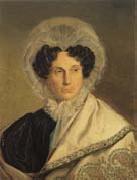 |
Alfred Rethel
|
|
1816 Diepenbend/Aachen-1859 Dusseldorf, was a German history painter. Rethel was born in Aachen in 1816. He showed an interest in art in his early life, and at the age of thirteen he executed a drawing which procured his admission to the academy of D??sseldorf. Here he studied for several years, and produced, among other works, a figure of St Boniface, which attracted much attention. At the age of twenty, Rethel moved to Frankfurt, and was selected to decorate the walls of the imperial hall in the Rmer with figures of famous men. At the same period he produced a series of designs illustrative of Old Testament history. Four years later, Rethel was the successful competitor for the work of ornamenting the restored council house of his native city with frescoes depicting prominent events in the career of Charlemagne, but the execution of this work was delayed for some six years. Meanwhile Rethel occupied himself with the production of easel pictures and of drawings. In 1842, he began a striking series of designs dealing with the Crossing of the Alps by Hannibal, in which the weird power which animates his later art becomes first apparent. In 1844 Rethel visited Rome, executing, along with other subjects, an altar-piece for one of the churches of his native land. In 1846, he returned to Aachen, and commenced his Charlemagne frescoes. |
|
|
|
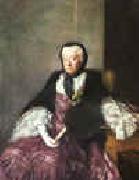 |
Allan Ramsay
|
|
1713-1784
British Allan Ramsay Galleries
Allan Ramsay was born in Edinburgh, Scotland, the eldest son of Allan Ramsay, poet and author of The Gentle Shepherd.
Ramsay's first wife, Anne Bayne, by Ramsay
Ramsay's second wife Margaret Lindsay, by RamsayFrom the age of twenty he studied in London under the Swedish painter Hans Huyssing, and at the St. Martin's Lane Academy; leaving in 1736 for Rome and Naples, where he worked for three years under Francesco Solimena and Imperiali (Francesco Fernandi). On his return in 1738 he first settled in Edinburgh, attracting attention by his head of Duncan Forbes of Culloden and his full-length portrait of the Duke of Argyll, later used on Royal Bank of Scotland banknotes. He later moved to London, where he was employed by the Duke of Bridgewater. His pleasant manners and varied culture, not less than his artistic skill, contributed to render him popular. His only serious competitor was Thomas Hudson, with whom he shared a drapery painter, Joseph van Aken. In 1739 he married his first wife, Anne Bayne, the daughter of a professor of Scots law at Edinburgh, Alexander Bayne of Rires (c.1684?C1737), and Mary Carstairs (1695??C1759). None of their 3 children survived childhood, and she died on 4 February 1743 giving birth to the third of them.
One of his drawing pupils was Margaret Lindsay, eldest daughter of Sir Alexander Lindsay of Evelick and Amelia Murray (granddaughter to David Murray, 5th Viscount of Stormont and sister to the naval officer John Lindsay). He later eloped with her and on 1 March 1752 they married in the Canongate Kirk, Edinburgh, though her father never forgave her for marrying an artist. Ramsay already had to maintain a daughter from his previous marriage as well as his two surviving sisters, but told Sir Alexander that he could provide Margaret with an annual income of £100 which would increase ??as my affairs increase, and I thank God, they are in a way of increasing?? and that his only motive for the marriage was ??my love for your Daughter, who, I am sensible, is entitled to much more than ever I shall have to bestow upon her??. There were three surviving children from their long and happy marriage, Amelia (1755?C1813), Charlotte (1758?C1818?), and John (1768?C1845).
Ramsay and his new wife spent 1754?C1757 together in Italy, going to Rome, Florence, Naples and Tivoli, researching, painting and drawing old masters, antiquities and archaeological sites, and (to earn an income) painting Grand Tourists' portraits. This and other trips to Italy involved more literary and antiquarian research than art. After their return, he was in 1761 appointed to succeed John Shackelton as Principle Painter in Ordinary to George III, beating Hudson to the post; and so fully employed was he on the royal portraits which the king was in the habit of presenting to ambassadors and colonial governors, that he was forced to take advantage of the services of a host of assistants--of whom David Martin and Philip Reinagle are the best known.
He gave up painting in about 1770 to concentrate on literary pursuits, his health shattered by an accidental dislocation of the right arm and his second wife's death in 1782. With unflinching pertinacity, he struggled until he had completed a likeness of the king upon which he was engaged at the time, and then started for his beloved Italy, leaving behind him a series of fifty royal portraits to be completed by his assistant Reinagle. For several years he lingered in the south, his constitution finally broken. He died at Dover on 10 August 1784. |
|
|
|
|
|
 |
Andrei Ryabushkin
|
|
(Russian:29 October [O.S. 17 October] 1861 - 10 May [O.S. 27 April] 1904) was a Russian painter. His major works were devoted to life of ordinary Russians of the 17th century.
Andrey Petrovich Ryabushkin was born in the village Stanichnaya sloboda, Borisoglebskiy uezd, Tambov gubernia in 1861. His father and brother were icon painters, and he started to help them from his early childhood. At 14 years old he became an orphan. A student of Moscow School of Painting, Sculpture and Architecture A. Kh. Preobrazhensky, who spent the summer in the village, happened to see the boyes drawings and was greatly impressed by them. He started to give him lessons and helped him to enter the Moscow School of Painting, Sculpture and Architecture. Ryabushkin was one of the youngest student of the school at all times.
Ryabushkin stayed for seven years (1875-82) in the Moscow School, learning from Vasily Perov and Illarion Pryanishnikov. His first large work Peasant Wedding was bought by Pavel Tretyakov in 1880. After the death of Vasiliy Perov, Ryabushkin moved to Saint Petersburg in 1882, and entered the Imperial Academy of Arts where he learned from Pavel Chistyakov. The classes soon disappointed him, however, and he began to spend more and more time either in the library of the academy or sketching in the streets.
His studies at the academy came to an end in 1892. He did not receive an award for his diploma work, Descent from the Cross, as was expected, because he did not follow the approved project. But the work was so good that the president of the academy, Grand Duke Vladimir Konstantinovich, provided Ryabushkin with a stipend for travel and studies abroad from his own means. Instead of going to Italy or Paris, Ryabushkin chose to make a tour of ancient Russian towns (Novgorod, Kiev, Moscow, Uglich, Yaroslavl). The inhabitants of them became his first models and his first critics. |
|
|
|
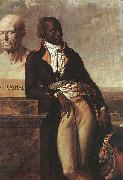 |
Anne-Louis Girodet de Roussy-Trioson
|
|
(also given as Anne-Louis Girodet de Roucy-Triosson, Anne-Louis Girodet-Trioson) January 5, 1767 - December 9, 1824), was a French painter and pupil of Jacques-Louis David, who was part of the beginning of the Romantic movement by adding elements of eroticism through his paintings. Girodet is remembered for his precise and clear style and for his paintings of members of the Napoleonic family.
|
|
 |
Antoine Rivalz
|
|
(1667, Toulouse - 1735) was a French painter. The son of Jean-Pierre Rivalz (who painted and designed the city's hôtel de ville), Antoine was the official painter to the town of Toulouse, a talented portraitist of the society of the city in the 18th century. He also produced a large number of drawings.
Antoine Rivalz began his training in the studios of his father Jean-Pierre, the sculptor Marc Arcis and the artist Raymond Lafage. In his training, he was particularly interested in studying classical works and the Baroque Italian masters. From 1685 to 1687 he trained at the Academie royale de peinture et de sculpture in Paris. On his return to Toulouse he received his first two commissions. In 1687 he set out for Rome, where he stayed for more than ten years. In 1694 he won second prize at the Accademia di San Luca with a drawing of The fall of the giants, with first prize going to Antonio Balestra and Felice Nardi. In Rome he became friends with other artists such as Carlo Maratta, Luigi Garzi and Benedetto Luti, and was more and more in demand for commissions from families in both Rome and Toulouse.
In 1703, he returned to Toulouse and was made painter of the city's hôtel de ville, a post he held until his death. Supported by an important studio, he received a large number of commissions - commemorative paintings, paintings of ordinance and armour, architectural projects, restorations. This post, however, allowed him above all to forge productive relations with the city's upper classes and benefit from a near-monopoly on public, religious and private commissions in the city.
He married his first cousin Louise Rivalz, with whom he had six children, including the future artist Pierre Rivalz, known as the "chevalier Rivalz". In 1726 he set up Toulouse's first art school and in 1750 letters patent from Louis XV turned it into the Academie royale de peinture et de sculpture de Toulouse, the only one in France (after that in Paris) to be allowed to bear that title.
|
|
|
|
|
|
 |
Anton Raphael Mengs
|
|
1728-1779
Dutch
Anton Raphael Mengs Gallery
Mengs was born in 1728 at Usti nad Labem (German: Aussig) in Bohemia on 12 March 1728; he died in Rome 29 June 1779. His father, Ismael Mengs, a Danish painter, established himself finally at Dresden, whence in 1741 he took his son to Rome.
In Rome, his fresco painting of Parnassus at Villa Albani gained him a reputation as a master painter. The appointment of Mengs in 1749 as first painter to Frederick Augustus, elector of Saxony did not prevent his spending much time in Rome, where he had married Margarita Quazzi who had sat for him as a model in 1748, and abjured the Protestant faith, and where he became in 1754 director of the Vatican school of painting, nor did this hinder him on two occasions from obeying the call of Charles III of Spain to Madrid. There Mengs produced some of his best work, and specially the ceiling of the banqueting-hall of the Royal Palace of Madrid, the subject of which was the Triumph of Trajan and the Temple of Glory. Among his pupils there was Agust??n Esteve. After the completion of this work in 1777, Mengs returned to Rome, and there he died, two years later, in poor circumstances, leaving twenty children, seven of whom were pensioned by the king of Spain. His portraits and autoportraits recall an attention to detail and insight, often lost from the grand manner paintings.
Besides numerous paintings in the Madrid gallery, the Ascension and St Joseph at Dresden, Perseus and Andromeda at Saint Petersburg, and the ceiling of the Villa Albani must be mentioned among his chief works. In 1911, Henry George Percy, 7th Duke of Northumberland, possessed a Holy Family, and the colleges of All Souls and Magdalen, at Oxford, possessed altar-pieces by Mengs's hand.
In his writings, in Spanish, Italian and German, Mengs has put forth his eclectic theory of art, which treats of perfection as attainable by a well-schemed combination of diverse excellences Greek design, with the expression of Raphael, the chiaroscuro of Correggio, and the colour of Titian. He would have fancied himself the first neoclassicist, while in fact he may be the last flicker of Baroque art. Or in the words of Wittkower, In the last analysis, he is as much an end as a beginning.
His intimacy with Johann Joachim Winckelmann, who constantly wrote at his dictation, has enhanced his historical importance, for he formed no scholars, and the critic must now concur in Goethe's judgment of Mengs in Winckelmann und sein Jahrhundert; he must deplore that so much learning should have been allied to a total want of initiative and poverty of invention, and embodied with a strained and artificial mannerism.
Mengs was famous for his rivalry with the contemporary Italian painter Pompeo Batoni. |
|
|
|
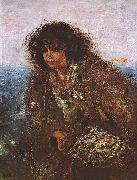 |
Anton Romako
|
|
(October 20, 1832 - March 8, 1889) was an Austrian painter.
Anton Romako was born in Atzgersdorf (now a district of Liesing, Vienna), as an illegitimate son of factory owner Josef Lepper and his housemaid Elisabeth Maria Anna Romako. He studied painting at the Academy of Fine Arts Vienna (1847-49) but his teacher, Ferdinand Georg Waldmeller, considered him talentless. Later, he studied in Munich (1849) under Wilhelm Kaulbach, and subsequently in Venice, Rome and London. In the early 1850s he studied privately in Vienna under Carl Rahl, whose style Romako adopted. In 1854 he began travels to Italy and Spain and in 1857 settled in Rome as the favourite portrait, genre, and landscape painter for the local colony of foreigners.
In 1862 Romako married Sophie Köbel, the daughter of architect Karl Köbel, and the pair had five children before Sophie left Romako in 1875 for her lover. In 1876 Romako returned to Vienna but failed to re-establish himself against the style representend by Hans Makart and increasingly relied on the charity of such wealthy patrons as Count Kuefstein. He made study trips to Hungary, Italy and France, and during the years 1882-84 he alternated between Paris and Geneva. Two daughters, Mathilde and Mary, committed suicide in 1887; Romako had never recovered from the shock. His last years were spent living in neglect near Vienna, where he died in poverty in 1889. Romako was buried at the Central cemetery in Vienna.
In 1953 a street in Atzgersdorf was named after the painter: Romakogasse. Anton Romako's painting "The battle of Lissa" was selected as a motive for a recent commemorative coin: the 20 euro S.M.S. Erzherzog Ferdinand Max minted on September 15, 2004.
His brother, Joseph von Romako, was a Naval Architect-Inspector of Austro-Hungarian Navy.
|
|
 |
ANTONIAZZO ROMANO
|
|
[Italian Early Renaissance Painter, 1430-ca.1510
Antoniazzo was born in the Colonna quarter of Rome.
He was influenced at first by the decorative manner of Benozzo Gozzoli and Beato Angelico, as well as by the local painters of Lazio. His first recorded work is from 1461, a replica (untraced) of the miraculous Virgin and Child of St. Luke in the Basilica of Santa Maria Maggiore of Rome, for the seignior of Pesaro, Alessandro Sforza.
From 1464 he worked for the papal court, producing at first a triptych of the Virgin and Child with Saints in Rieti. In 1467 he completed the decoration of the funerary chapel of Cardinal Bessarion in the church of Santi Apostoli of Rome, not far from his birthplace. In the centre of the decoration was an icon of the Virgin, now in the Chapel of St Anthony, a copy of the Byzantine icon in the Santa Maria in Cosmedin, the church of the Greeks in Rome. This icon in the Santi Apostoli is one of the most remarkable examples of Antoniazzo's considerable production of Virgins, generally taken from Byzantine models: he was indeed a much sought-after copier of icons. Later he worked to a series of frescoes in the Monastery of Tor de' Specchi in Rome, featuring stories of the life of S. Francesca Romana, and to the decoration of the public rooms of the Palazzo Venezia.
In the 1470s Antoniazzo worked to the decoration of the Vatican Palace with artists like Perugino, Melozzo da Forl?? and Ghirlandaio. Through their influence his figures acquired gentler expressions and their garments were ornamented with decorative patterns, though always retaining several Medieval features.
Together with Melozzo he worked to frescoes in Santa Maria sopra Minerva, and subsequently painted for that church a famous Annunciation (1482). The painting shows the Dominican Juan de Torquemada (cardinal) (d. 1468) presenting poor girls dowered by the guild of the Annunciation that he founded to the Virgin Mary.
In the years between 1475 and 1480 Antoniazzo's production of altarpieces and panels with images of the Virgin increased as a result of the encouragement of the cult of the Virgin by Pope Sixtus IV. His later works show an increasing mannerism in their features, which were later imitated by several painters, whose works had been often attributed to the master.
Antoniazzo was one of the three founders of the Compagnia di San Luca, the guild of painters and illuminators in Rome, and signed the statutes in 1478. |
|
|
|
|
|
|
|
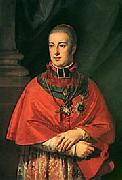 |
Archduke Rudolf of Austria
|
|
Rudolf Johannes Joseph Rainier von Habsburg-Lothringen, Archduke and Prince Imperial of Austria, Prince Royal of Hungary and Bohemia (8 January 1788 - 24 July 1831) was a Cardinal, an Archbishop of Olomouc, and a member of the House of Habsburg-Lorraine.
Born in Pisa, Italy, he was the youngest son of Emperor Leopold II and Maria Louisa of Spain. He was elected archbishop of Olomouc in 1819 and became cardinal in the year 1820.
In 1803 or 1804, Rudolf began taking lessons in piano and composition from Ludwig van Beethoven. The two became friends, and Rudolph became a supporter and patron of Beethoven; their meetings continued until 1824. Beethoven dedicated 14 compositions to Rudolph, including the Archduke Trio, the Hammerklavier Sonata, the Emperor Concerto and the Missa Solemnis. Rudolph, in turn, dedicated one of his own compositions to Beethoven. The letters Beethoven wrote to Rudolph are today kept at the Gesellschaft der Musikfreunde in Vienna.
On 24 March 1819 he was appointed, at the age of 31, Archbishop of Olomouc in the present day Czech Republic but then part of the Austrian Empire. He was made Cardinal-Priest of the titular church of S. Pietro in Montorio by Pope Pius VII on 4 June 1819. He was ordained a priest on 29 August 1819, and consecrated a bishop on 26 September.
In 1823 - 24, he was one of the 50 composers who composed a variation on a waltz by Anton Diabelli for Vaterländischer Kenstlerverein. In Rudolf's case, the music was published anonymously, as by "S.R.D" (standing for Serenissimus Rudolfus Dux).
|
|
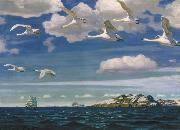 |
Arkady Alexandrovich Rylov
|
|
Arkady Alexandrovich Rylov (Russian, 29 January [O.S. 17 January] 1870 - June 22, 1939) was a Russian and Soviet Symbolist painter.
Biography
Rylov was born in the village Istobenskoye, Vyatka gubernia. He was brought in the family of his stepfather, a notary (Rylov's father had a psychiatric illness). He moved to Saint Petersburg and studied at the Technical Design School of Baron Schtiglitz (1888-1891), then at the Imperial Academy of Arts under Arkhip Kuindzhi (1894-1897).
In the Blue Expanse, 1918Rylov was a member of the Mir iskusstva movement and its spin-off Union of Russian Artists also a member of the Association of Artists of the Revolutionary Russia. He was a chairman of the Kuindzhi Society. |
|
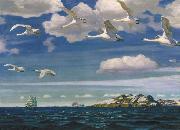 |
Arkady Rylov
|
|
(Russian: 29 January 1870 - June 22, 1939) was a Russian and Soviet Symbolist painter.
Rylov was born in the village Istobenskoye, Vyatka gubernia. He was brought in the family of his stepfather, a notary (Rylov's father had a psychiatric illness). He moved to Saint Petersburg and studied at the Technical Design School of Baron Schtiglitz (1888-1891), then at the Imperial Academy of Arts under Arkhip Kuindzhi (1894-1897).
Rylov was a member of the Mir iskusstva movement and its spin-off Union of Russian Artists also a member of the Association of Artists of the Revolutionary Russia. He was a chairman of the Kuindzhi Society.
He started as a historical painter (his graduation work in the Imperial Academy of Arts was Assault of Pechenegs on a Slav village but became a predominately landscape painter. Still many of his paintings have some allusions with Russian history.
Many of his landscapes painted after the October Revolution were seen as symbols of the revolutionary Freedom. At that time he also painted some typical Socialist Realism compositions like Lenin in Razliv. He taught in the Academy of Arts. In his studio he created almost a small nature reserve. There lived squirrels, rabbits, monkey Manka and many wild birds (without cages) and two anthills. According to Mikhail Nesterov wild animals and birds loved Rylov and often came to his studio.
|
|
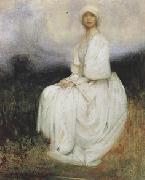 |
Arthur hacker,R.A.
|
|
1858-1919
was an English classicist painter. Born in London in 1858, Hacker was the son of Edward Hacker, a line engraver specialising in animal and sporting prints (who was also for many years the official Registrar of Births, Marriages and Deaths for Kentish Town in the St Pancras registration district, north London). In his art he was most known for painting religious scenes and portraits, and his art was also influenced by his extensive travels in Spain and North Africa. He studied at the Royal Academy between 1867 and 1880, and at the Atelier Bonnat in Paris. He was twice exhibited at the Royal Academy, in 1878 and 1910, and was elected an Academician in 1910. In 1894 he was the subject of a bust by Edward Onslow Ford. An original portrait by Hacker of Sir Alfred Keogh by hangs in the RAMC HQ Mess at Millbank, London. He died in London on November 12, 1919. In 1902, |
|
|
|
 |
Auguste Rodin
|
|
French Sculptor, 1840-1917
.French sculptor. Insolvent and repeatedly rejected by the École des Beaux-Arts, he earned his living by doing decorative stonework. Not until his late 30s, after a trip to Italy, did he develop a personal style free of academic restraints and establish his reputation as a sculptor with The Age of Bronze (exhibited 1878), whose realism was so great that he was accused of forming its mold on a living person. His Gates of Hell, a bronze door commissioned in 1880 for a proposed Musee des Arts Decoratifs, remained unfinished at his death, but two of its many figures were the bases of his most famous images, The Thinker (1880) and The Kiss (1886). His portraits include monumental figures of Victor Hugo and Honore de Balzac. Though these and many other works caused controversy for their unconventionality, he was successful enough that he could establish a workshop where he executed only molds, leaving the casting of bronze and the carving of marble to assistants. To his sculpture he added book illustrations, etchings, and numerous drawings, mostly of female nudes. |
|
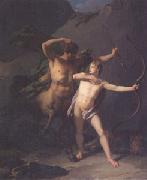 |
Baron Jean-Baptiste Regnault
|
|
Paris 1754-1829
French painter. His first teacher was the history painter Jean Bardin, who took him to Rome in 1768. Back in Paris in 1772, he transferred to the studio of Nicolas-Bernard Lepicie. In 1776 he won the Prix de Rome with Alexander and Diogenes (Paris, Ecole N. Sup. B.-A.) and returned to Rome, where he was to spend the next four years at the Academie de France in the company of Jacques-Louis David and Jean-Francois-Pierre Peyron. While witnessing at first hand Peyron's development of a manner indebted to Poussin and David's conversion to Caravaggesque realism, Regnault inclined first towards a Late Baroque mode in a Baptism of Christ (untraced; recorded in two sketches and an etching), then, in Perseus Washing his Hands (1779; Louisville, KY, Speed A. Mus.), to the static Neo-classicism of Anton Raphael Mengs. |
|
|
|
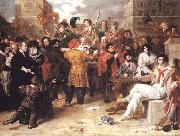 |
Benjamin Robert Haydon
|
|
English Romantic Painter, 1786-1846
1786-1846.was an English historical painter and writer. Haydon was born at Plymouth. His mother was the daughter of the Rev. Benjamin Cobley, rector of Dodbrooke, near Kingsbridge, Devon. Her brother, General Sir Thomas Cobley, was renowned for his part in the siege of Ismail. Benjamin's father, a prosperous printer, stationer and publisher, was well known in Plymouth. Haydon, an only son, at an early date showed an aptitude for study, which was carefully fostered by his mother. At the age of six he was placed in Plymouth grammar school, and at twelve in Plympton St Mary School, the same school where Sir Joshua Reynolds had received most of his education. On the ceiling of the school-room was a sketch by Reynolds in burnt cork, which Haydon loved to sit and look at. Whilst at school he had some thought of adopting the medical profession, but he was so shocked at the sight of an operation that he gave up the idea. Reading Albinus inspired him with a love for anatomy; but from childhood he had wanted to become a painter. Full of energy and hope, he left home, on 14 May 1804, for London, and entered the Royal Academy as a student. He was so enthusiastic that Henry Fuseli asked when he ever found time to eat. Aged twenty-one (1807) Haydon exhibited, for the first time, at the Royal Academy, The Repose in Egypt, which was bought by Thomas Hope the year after for the Egyptian Room at his townhouse in Duchess Street. This was a good start for the young artist, who shortly received a commission from Lord Mulgrave and an introduction to Sir George Beaumont. In 1809 he finished his well-known picture of Dentatus, which, though it increased his fame, resulted in a lifelong quarrel with the Royal Academy, whose committee had hung it in a small side-room instead of the great hall. That same year, he took on his first pupil, Charles Lock Eastlake, later destined to become one of the great figures of the British art establishment. In 1810 his financial difficulties began when the allowance of £200 a year from his father was stopped. His disappointment was embittered by the controversies in which he now became involved with Beaumont, for whom he had painted his picture of Macbeth, and Richard Payne Knight, who had denied the beauties as well as the money value of the Elgin Marbles. |
|
|
|
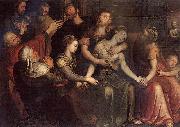 |
Bernaert de Ryckere
|
|
Bernaert de Rijckere (c1535, Kortrijk - 1590, Antwerp), was a Flemish Renaissance painter.
According to Karel van Mander he was born in Kortrijk and was admired there for an altarpiece depicting Christ bearing the cross, which he made for the St. Marten's church of the brothers of the Cross there. He later took on a different style that Karel van Mander had heard of but had not seen to be able to judge it for himself. He said he moved to Antwerp and joined the Guild of St. Luke there in 1561.
According to the Netherlands Institute for Art History he was the teacher of his son, the painter Abraham de Rijcke, and is known for landscapes and historical allegories. |
|
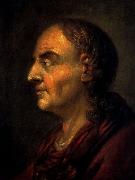 |
Bernhard Rode
|
|
Bernhard Rode (25 July 1725 - died 28 June 1797) was a Prussian artist and engraver well-known for portraying historical scenes and allegorical works. He knew most of the central figures in the Berlin Enlightenment as Friedrich Nicolai and Gotthold Lessing, and the philosophical and political discussions of the Berlin Philosophs informed much of the subject matter of his artistic work. His paintings include several works depicting, in various guises, the King of Prussia Frederick the Great, who ruled the Prussia during much of Rode's lifetime. Rode was director of the Berlin Academy of the Arts from 1783 until his death in 1797.
Rode was the son of a goldsmith Christian Bernhard Rode and his wife, Anna Sophie. The copper engraver Johann Heinrich Rode and the sculptor Philipp Rode were his brothers. He received his earliest artistic training from his father and his earliest training in drawing from a painter, N. Meller. His four-year education at the studio of the court painter Antoine Pesne, an influential painter in Berlin and Brandenburg, was important to his professional development. During his apprenticeship, he learned to paint portraits. In 1748, Rode began a study trip of several years. He spent 18 months in the studio of Jean Restout and Charles Andre van Loo (sometimes known as Carle van Loo or Vanloo). He became acquainted with Jean-Baptiste Deshayes and developed his talent and interest in the medium of history painting. In Venice and Rome, he studied the old masters. In 1755 or 1756, he returned to Berlin, and he married Sophie Luise, but the earliest years of their marriage remained childless. |
|
|
|
|
|
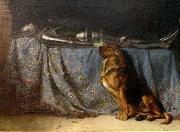 |
Briton Riviere
|
|
(14 August 1840 C 1920) was an Irish artist born in London, England.
His father, William Riviere, was for some years drawing-master at Cheltenham College, and afterwards an art teacher at Oxford University. He was educated at Cheltenham College and at Oxford, where he took his degree in 1867. For his art training he was indebted almost entirely to his father, and early in life made for himself a place of importance among the artists of his time.
His first pictures appeared at the British Institution, and in 1857 he exhibited three works at the Royal Academy, but it was not until 1863 that he became a regular contributor to the Academy exhibitions. In that year he was represented by "The Eve of the Spanish Armada", and in 1864 by a "Romeo and Juliet". Subjects of this kind did not, however, attract him long, for in 1865 he began, with a picture of a "Sleeping Deer-hound", a series of paintings of animal-subjects which later occupied him almost exclusively.
|
|
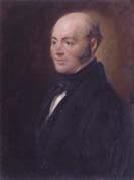 |
C.R. Leslie
|
|
English genre painter , 1794-1859
was an American artist best known for his cartoons and caricatures of actors and other celebrities. Though his work was heavily in demand through the 1920s and is often considered to epitomize the era, his personal life was troubled by mental illness, and he was nearly forgotten soon after his suicide, shortly before his fortieth birthday. English genre painter, was born in London on 19 October 1794. His parents were American, and when he was five years of age he returned with them to their native country. They settled in Philadelphia, where their son was educated and afterwards apprenticed to a bookseller. He was, however, mainly interested in painting and the drama, and when George Frederick Cooke visited the city he executed a portrait of the actor from recollection of him on the stage, which was considered a work of such promise that a fund was raised to enable the young artist to study in Europe. He left for London in 1811, bearing introductions which procured for him the friendship of West, Beechey, Allston, Coleridge and Washington Irving, and was admitted as a student of the Royal Academy, where he carried off two silver medals. At first, influenced by West and Fuseli, he essayed high art, and his earliest important subject depicted Saul and the Witch of Endor; but he soon discovered his true aptitude and became a painter of cabinet-pictures, dealing, not like those of David Wilkie, with the contemporary life that surrounded him, but with scenes from the great masters of fiction, from Shakespeare and Cervantes, Addison and Moliere, Swift, Sterne, Fielding and Smollett. Of individual paintings we may specify Sir Roger de Coverley going to Church (1819); May-day in the Time of Queen Elizabeth (1821); Sancho Panza and the Duchess (1824); Uncle Toby and the Widow Wadman (1831); La Malade Imaginaire, act iii. sc. 6 (1843); and the Dukes Chaplain Enraged leaving the Table, from Don Quixote (1849). |
|
 |
Camille Roqueplan
|
|
Camille Joseph Etienne Roqueplan, 18 February 1802 in Mallemort; † 30 September 1855 in Paris) was a French painter.
|
|
|
|
|

